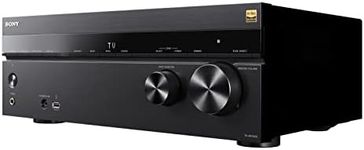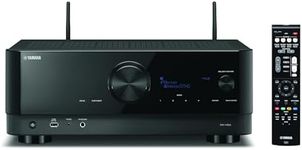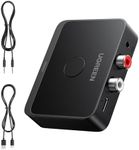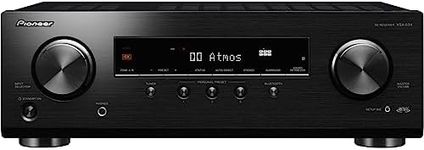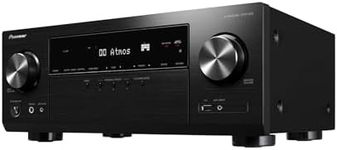Buying Guide for the Best Av Receivers
Choosing the right AV receiver can significantly enhance your home entertainment experience. An AV receiver acts as the hub for your home theater system, connecting and managing audio and video sources to deliver high-quality sound and visuals. To make an informed decision, it's important to understand the key specifications and how they align with your needs.ChannelsChannels refer to the number of speakers the receiver can support. This is important because it determines the surround sound experience you can achieve. Common configurations include 5.1, 7.1, and 9.1 channels. A 5.1 system includes five speakers and one subwoofer, suitable for smaller rooms or basic setups. A 7.1 system adds two more speakers for a more immersive experience, ideal for medium-sized rooms. A 9.1 system includes additional height or ceiling speakers for a truly enveloping sound, perfect for larger spaces or advanced setups. Choose based on the size of your room and your desire for surround sound immersion.
Power OutputPower output, measured in watts per channel, indicates how much power the receiver can deliver to each speaker. This is crucial for achieving clear and dynamic sound, especially at higher volumes. Receivers typically range from 50 to 150 watts per channel. Lower power output (50-75 watts) is sufficient for small to medium rooms and casual listening. Higher power output (100-150 watts) is better for larger rooms or if you enjoy loud, impactful sound. Consider your room size and listening habits when choosing the right power output.
ConnectivityConnectivity options determine how many and what types of devices you can connect to your receiver. This includes HDMI inputs and outputs, optical and coaxial digital inputs, and analog inputs. HDMI is the most important for modern setups, as it supports high-definition video and audio. More HDMI ports allow you to connect multiple devices like gaming consoles, Blu-ray players, and streaming devices. Optical and coaxial inputs are useful for older devices. Ensure the receiver has enough ports to accommodate all your current and future devices.
Audio FormatsSupport for various audio formats ensures compatibility with different types of media and enhances sound quality. Common formats include Dolby Digital, DTS, Dolby Atmos, and DTS:X. Dolby Digital and DTS are standard surround sound formats suitable for most content. Dolby Atmos and DTS:X provide advanced, object-based audio for a more immersive experience, ideal for movies and high-quality music. Choose a receiver that supports the formats you frequently use or plan to use for the best audio experience.
Video SupportVideo support features, such as 4K pass-through, HDR compatibility, and upscaling, affect the quality of the video signal processed by the receiver. 4K pass-through ensures that 4K content from your devices is displayed correctly on your TV. HDR compatibility enhances the color and contrast of the video, providing a more vibrant picture. Upscaling improves the quality of lower-resolution content. If you have a 4K TV or plan to upgrade, ensure the receiver supports these features for optimal video performance.
Network and StreamingNetwork and streaming capabilities allow you to access online content and stream music directly to your receiver. Features like Wi-Fi, Bluetooth, and built-in streaming services (e.g., Spotify, Pandora) are important for convenience and versatility. Wi-Fi enables connection to your home network for streaming and updates. Bluetooth allows easy pairing with smartphones and tablets. Built-in streaming services provide direct access to music without needing additional devices. Consider these features if you enjoy streaming music or want a more connected home theater system.
Room CalibrationRoom calibration technology automatically adjusts the receiver's settings to optimize sound based on your room's acoustics. This is important for achieving the best audio performance regardless of your room's shape and size. Systems like Audyssey, YPAO, and MCACC use microphones to measure sound and make adjustments. This feature is particularly useful if you want hassle-free setup and optimal sound quality. Look for receivers with room calibration if you want to ensure the best audio experience in your specific environment.
